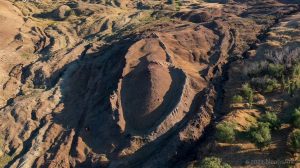Evidence of Ancient Flood Discovered at Turkey’s ‘Noah’s Ark’ Site

 According to the Bible, Noah’s Ark saved humanity and all the animals from annihilation during an ancient flood. Now, 5,000 years later, scientists claim to have discovered the location of the famous boat.
According to the Bible, Noah’s Ark saved humanity and all the animals from annihilation during an ancient flood. Now, 5,000 years later, scientists claim to have discovered the location of the famous boat.
An international team of researchers suggests that a boat-shaped mound 18 miles (30km) south of Mount Ararat in Turkey, known as the Durupinar Formation, is the fossilized remains of a wooden vessel.
This 163-metre (538ft) geological structure, made of limonite, has long intrigued researchers due to its resemblance to the Ark’s biblical description.
New evidence indicates that the mound experienced a catastrophic flood 5,000 years ago, aligning with the biblical account of a flood between 3000 and 5500 BC.
“Our studies show that this region harbored life in that period and that, at some point, it was covered by water, which reinforces the possibility that a catastrophic event of great magnitude occurred,” the researchers said.

Since 2021, the Mount Ararat and Noah’s Ark Research Team, a collaboration between Istanbul Technical University, Agri Ibrahim Cecen University, and Andrews University, has been studying the site.
At the 7th International Symposium on Mount Ararat and Noah’s Ark, researchers presented new evidence supporting their theory.
Soil and rock samples from the Durupinar Formation, analyzed at Istanbul Technical University, revealed clay-like materials, marine deposits, and remnants of marine life like molluscs, dating between 3,500 and 5,000 years old. This suggests the area was submerged during a period consistent with the biblical flood.
Lead researcher Professor Faruk Kaya stated, “According to the initial results, it’s believed there were human activities in this region since the Chalcolithic period.”
This could strengthen the claim that the Durupinar Formation is Noah’s Ark. The structure’s shape and location also support this theory. The Bible describes the Ark as 300 cubits long, 50 cubits wide, and 30 cubits high.
Using the Egyptian cubit (52.4 cm), this translates to 515ft (157m), close to the Durupinar Formation’s 538ft (168m). Additionally, the site is 18 miles south of Mount Ararat, where the Ark is said to have rested.
However, the evidence is not conclusive. Professor Kaya admits, “With the dating, it is not possible to say that the ship is here.”
Geologists, including Professor Lorence Collins, argue that the Durupinar Formation is a natural geological feature formed by erosion and landslide debris.
Collins also notes that the structure is older than the surrounding flood deposits, and fossilising wood into stone would take millions of years, not 5,000.
Despite skepticism, the research team continues to study the site and plans to build a visitor centre.




